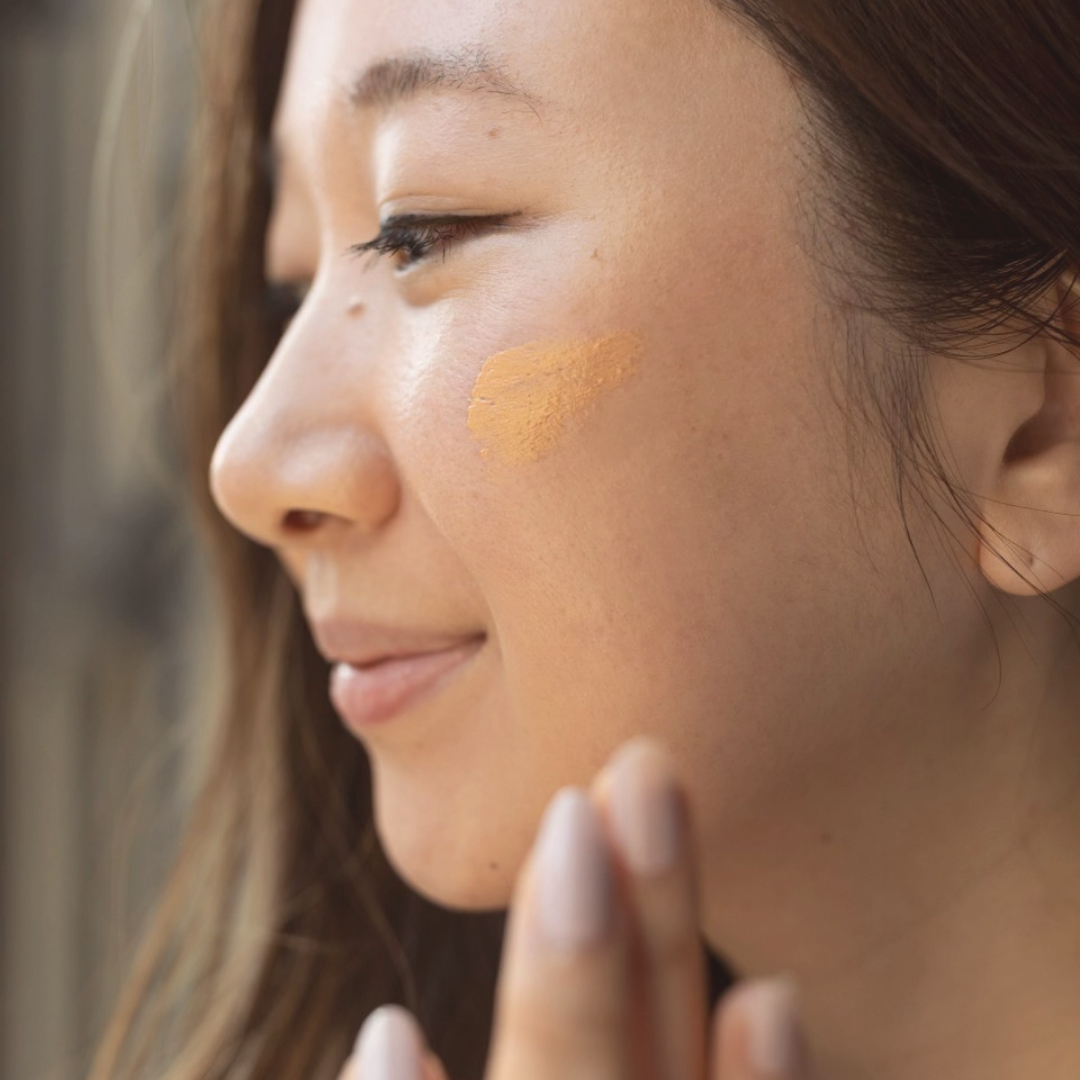By Kate Downes, LAc TCM Practitioner
Do you ever wish you could look inside your body to understand what’s really going on with your health?
With Chinese face mapping, you can! This ancient diagnostic practice teaches you to observe changes in your face and skin and determine what those changes could mean for your internal health.
In this blog, we’re diving into the world of Chinese face mapping to show you how you can use this simple method to make better choices for your skin and body.
What is Chinese Face Mapping?
Chinese face mapping, or mien shiang, is just what it sounds like! It is a practice that views the face as a “map,” with different areas corresponding to different organ systems in Chinese medicine. The face is divided into zones, and each zone corresponds to a particular organ or system.
Chinese medicine views the body as one energetic web where qi, blood, fluids, tissues, and organs are all interlinked. For this reason, we can understand what is happening below our skin simply by observing and diagnosing certain patterns of imbalance on the surface. When an organ system is out of balance, we can see signs on that corresponding region of the face. Face mapping also gives us a window into your emotional and mental health, as well as physical health.

How to Read Your Face with Chinese Face Mapping
-
Observe.
Observe your skin. Look first at your face as a whole, then examine each different area.
-
Identify.
Note any areas of redness, oiliness, dryness, peeling, dullness, discoloration, breakouts, or other issues.
-
Heal.
Determine which zone/organ system these imbalances relate to and make the appropriate health changes to improve your skin and health.
Read Your Face: The Chinese Face Mapping Zones
Forehead and Hairline: Small Intestine and Urinary Bladder
The upper forehead region corresponds to the small intestine and bladder. If you notice redness, breakouts, or oiliness in this area, it likely means you are struggling to eliminate waste properly. Toxins are building up in your system, and your digestive tract needs a “clean sweep.”
If you notice deep lines in the forehead, this can signify too much worry, chronic stress, and anxiety.
What to Do: Drink more water, eat more fiber, and fill up on a rainbow of fresh fruits and veggies. Skip inflammatory drinks like soda or coffee and instead sip on lemon water and herbal teas.
For forehead lines, make stress relief a priority. Meditate daily and use facial gua sha to smooth skin texture and relieve tension.
Between the Eyebrows and the Temples: Liver and Gallbladder
The small patch of skin between the eyebrows and the temple area corresponds to the Liver and Gallbladder system. In Chinese medicine, the Liver is highly susceptible to stress, dietary inflammation, and emotional upset. When you see redness or breakouts here, it’s a good sign that stress or poor diet is overwhelming your Liver system.
This region is also a common area for people to develop those pesky “number 11” lines. These can symbolize high stress, irritation, or chronic squinting.
What to Do: If you see signs of irritation in this area, your Liver needs a cleanse! Try a gentle whole foods detox and drink plenty of water. Chrysanthemum tea is a great way to clear heat and inflammation in the Liver system and the skin. Use gua sha to smooth deep lines between the eyebrows. Take breaks from long hours at the computer and always wear your sunglasses outside!
- Top/Corners of the Forehead: Kidney and Urinary Bladder
Consistent breakouts or dryness in the upper forehead corners correspond to the Kidney and Urinary Bladder systems. This typically means your body is dehydrated or you are eating too many salty foods.
What to Do: Hydrate! Drink more water and steer clear of salty foods and sodas (which contain high sodium levels). Switch your coffee to matcha tea, which gives you a natural boost of energy without the dehydrating and irritating effects of caffeine.
Nose: Heart and Digestive Organs
The area below the nose corresponds to the Heart system, and imbalances here can indicate stress, high blood pressure, and other cardiovascular issues. Visible blood vessels tend to signal poor circulation and stress, while blackheads indicate congestion in the chest region.
Breakouts on the nose or sides of the nose can be a sign of build-up in the digestive tract, usually due to a diet high in processed foods or dairy.
What to Do: Focus your diet on anti-inflammatory foods and heart health. Eat plenty of omega-3 fatty acids (like nuts, seeds, avocados, and fatty fish) and avoid processed or junk foods. Cook more warming soups with Traditional Chinese Medicine herbs like goji berries, chrysanthemum, aged tangerine peel to heal the digestive tract.
Cheeks: Lungs and Stomach
Respiratory issues show up most commonly on the cheeks. If you smoke or struggle with allergies, this area can become red, bumpy, dry, or acne-prone. Whiteheads on the cheeks can be a sign of mucus trapped in the lungs. Long-stranding grief, sadness, or resentment can also impact the Lung system and show up as congestion on the face.
Redness high on the cheeks can be related to heat in the Stomach, which is often caused by smoking or an inflammatory diet.
What to Do: If you are a smoker, this is a good sign that it’s time to quit! For those with allergies or chronic lung issues, be sure to “clear the air” both at home and in your personal life. Change your air filters, open the windows for some fresh air, and switch to natural air fresheners like Lunar Rose Mist. Release emotional tension with journaling, yoga, meditation, or talking with a friend.
• Eyes: Kidneys
The eye area (eyelids and under eyes) is related to the Kidney system in Chinese medicine. This system manages fluids, metabolism, and the stress response. When the Kidney system is worn down or lacking support, the eye area becomes dark, droopy, or puffy.
What to Do: If you notice that you consistently have puffy eyes or dark eye circles, your Kidney needs a break! Drink plenty of water and eat foods that nourish the Kidneys like black beans, seaweeds, bone broth, nuts, dark leafy greens, and shiitake mushrooms.
Prioritize sleep and make sure you’re getting at least 7 hours per night. Manage your stress by taking more breaks during the day and dedicating more time to self-care. Malaya Organics Lavender & Vanilla Bath Salts are the perfect way to rejuvenate your Kidney system and restore brightness to your eyes. This soothing bath blend helps you release tension and prepares your mind for a night of restorative sleep.
• Mouth: Stomach and Small Intestine
The mouth area is related to the Stomach and Small Intestine organs - two key players in the digestive system. If you notice breakouts around the mouth, this signifies that you are eating too much sugar, junk food, or greasy meals.
Redness or ulcers around the mouth can indicate dryness in the Stomach due to smoking, a diet high in dry or spicy foods, or stress. Dry lips are an overall sign of dryness and dehydration in the body.
Marionette lines (the long lines that extend from the bottom of the nose to the sides of the mouth) are called “purpose” lines in Chinese face mapping. Faint lines here show that you have a purpose but have not committed to it, while prominent lines mean you are fully living your purpose (flaunt it!).
What to Do: Because this area corresponds directly to the digestive organs, a change in diet can help significantly! Cook more of your meals at home from scratch with fresh produce, whole grains, and small portions of quality proteins. Avoid sugar, caffeine, and alcohol when possible. For dry lips, hydrate with lots of fresh water and lather on the strengthening yet nurturing YINA Recovery Lip Treatment to heal your lip tissue fast.
• Chin and Jaw: Reproductive Organs, Hormones
The chin and jawline are common areas for women to develop adult acne due to hormone imbalances. This is especially true if you notice that your breakouts come and go or fluctuate with your menstrual cycles.
What to Do: The key to eliminating chin and jawline breakouts and irritation is to get your hormones in balance. Focus on an anti-inflammatory diet and avoid refined sugar whenever possible (it can disrupt your hormone and insulin balance).
Because hormone balance is greatly impacted by stress, making time for self-care is crucial! Create a nighttime ritual that keeps you calm and clears your skin at the same time. We recommend Unearth Malee White Tea Calamansi Soap, paired with the Face Scrub Pad, followed by the Over the Moon Facial Oil.
Want Better Health? Listen to Your Skin! Your skin has so much to share; you just need to listen. By using some of these Chinese face mapping tips to understand what’s happening below the surface of your skin, you can learn to be your own health detective.




